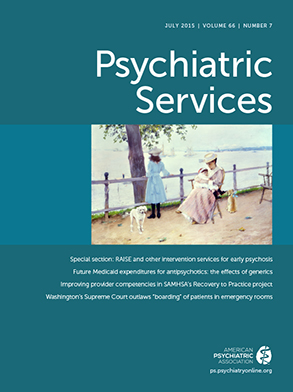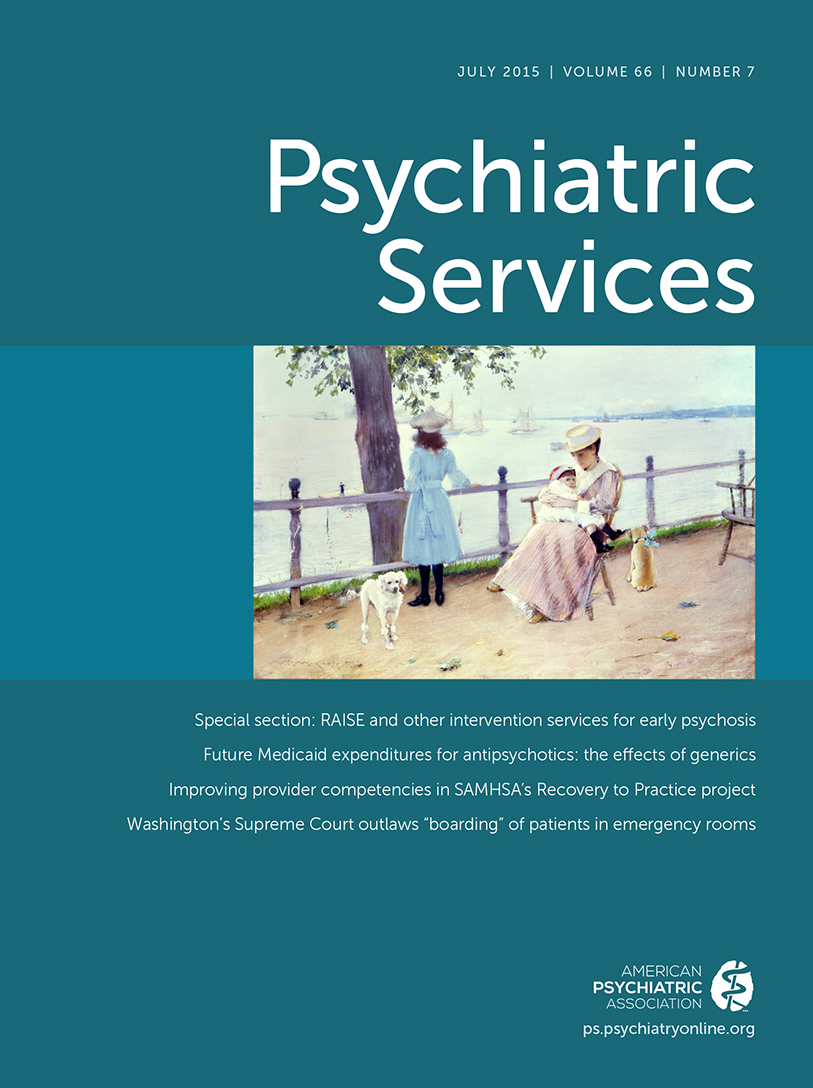The number of older adults identifying as lesbian, gay, or bisexual (LGB) is projected to rapidly increase over the next few decades as the U.S. population becomes older and more diverse (
1–
4). The aging of the U.S. population is expected to place a greater demand on the mental health care system (
5), reflecting, in part, a large increase in the number of older Americans with psychiatric disorders (
6). Despite these epidemiological changes, empirical efforts to measure use of mental health services among LGB older adults have been notably lacking (
1,
7,
8). As an initial step to assess need and to develop tailored interventions and public health policies, it is important to characterize mental health service use among LGB older adults and to determine factors that may account for service utilization in this population.
For older adults with depression or other psychiatric disorders, there are efficacious treatments—including medication, psychotherapy, or both—that can mitigate suffering (
9–
12). However, engaging older adults in treatment by a mental health specialist—for example, a psychiatrist, clinical psychologist, or social worker—is a considerable challenge (
13–
16). In fact, older adults are more likely than their younger counterparts to receive psychiatric care from a nonpsychiatric provider, such as a primary care physician (
17), in part because of a shortage of mental health clinicians specializing in aging (
5). Past research has demonstrated that LGB adults utilize mental health services at higher rates and for a longer duration compared with heterosexuals (
18–
21). The reasons for this finding, however, are not clear. Furthermore, it is not well understood if this association is true for older LGB adults in particular.
Potential Determinants of Mental Health Service use
Little research to date has explored factors that might explain mental health service use in the growing population of LGB older adults. The minority stress model (
22) represents a conceptual framework for identifying potential determinants of mental health service use among LGB older adults. The model posits that social forces—including discrimination, stigma, and prejudice—create an adverse environment for individuals in sexual minority groups, conferring increased risk for stress responses such as alcohol abuse, psychological distress, or poor perceived health. However, it is possible that individuals in sexual minority groups may engage in coping behaviors in response to the stress of having a stigmatized identity. These strategies might include utilization of counseling, psychiatric medication, and other mental health services (
22).
Minority stress may manifest as nonspecific psychological distress, which has a heterogeneous presentation and is broadly characterized by depressive symptoms, anxious symptoms, or both (
23). One study estimated that among men ages 25 to 74, members of sexual minority groups were approximately three times more likely than heterosexuals to report elevated psychological distress (
18). Similarly, among adults ages 50 and older, LGB respondents had significantly higher rates of psychological distress compared with heterosexuals (
24). In later life, untreated psychological distress has pernicious health outcomes, including hastened mortality (
25,
26). It is possible that this stress response may explain mental health service use among LGB older adults. However, few empirical studies have investigated this possibility.
Excessive alcohol use represents another potential determinant of mental health service utilization among LGB older adults. According to studies of younger and middle-aged adults, LGB individuals are significantly more likely to report excessive alcohol use, experience greater alcohol-related morbidity, such as impairment in daily activities, and are more likely to report receiving treatment for alcohol use compared with heterosexuals (
27,
28). In a population-based survey of older adults, LGB individuals were significantly more likely than heterosexuals to report excessive alcohol use (
29), although no studies to our knowledge have examined if these elevated rates might account for mental health service utilization among this population.
For older adults in particular, mental health is inextricably linked to general medical health (
26,
30), and thus a perception that one’s general medical health is poor may be an additional factor that accounts for service use among LGB older adults. Specifically, psychiatric care needs may manifest as somatic complaints (
31), and therefore rating one’s health as poor may serve as a proxy for mental illness. Indeed, past research has demonstrated elevated levels of poor general health among LGB older adults (
32).
Study Objectives
The purpose of this study was to describe and compare mental health service use among LGB and heterosexual adults ages 50 and older. Informed by the minority stress model (
22), we also sought to identify potential mediators that might explain mental health service use among LGB older adults. Drawing from prior research that demonstrated greater mental health services utilization among LGB adults ages 18 and older (
18), we hypothesized that LGB older adults will be more likely than heterosexual older adults to have utilized counseling and psychiatric medications in the past year. Earlier studies have reported increased mental health concerns, such as alcohol abuse and psychological distress, and poor self-perceived general medical health among LGB persons (
33); individuals who report similar concerns and observations are more likely to utilize mental health treatment (
16). Accordingly, we hypothesized that psychological distress, excessive alcohol use, and poor perceived general medical health will simultaneously mediate the association between sexual orientation and past-year counseling and psychiatric medication use. The findings of the study will be a key step toward developing tailored interventions and public health policies for the growing population of LGB older adults.
Discussion
Very little is known about use of mental health services among vulnerable subpopulations of older adults, including those who are LGB (
7,
44). To address this gap, we characterized mental health service use in a large, diverse sample of community-dwelling LGB older adults and determined if associations between sexual orientation and service use were accounted for by psychological distress, excessive alcohol use, and poor self-perceived general medical health.
Consistent with our first hypothesis, LGB older adults were over two times more likely to have received counseling and were nearly two times more likely to have taken psychiatric medications in the past year, compared with heterosexual older adults. These findings remained significant even after the analyses controlled for demographic characteristics—for example, sex—and robust barriers to mental health services, such as health insurance. Our findings are consistent with a previous study, which found that LGB adults in midlife were over three times more likely than other middle-aged adults to report seeing a mental health provider in the past year (
18). However, to our knowledge, this study is the first empirical investigation describing mental health service use among LGB adults in later life.
In order to identify factors that explain differences in service use between heterosexual and LGB older adults, we assessed the role of multiple simultaneous mediators—perceived general medical health, psychological distress, and excessive alcohol use. Contrary to our second hypothesis, the associations between sexual orientation and counseling and psychiatric medication use were not explained by the proposed mediators included in our model. Rather, we found that perceived general medical health, psychological distress, and excessive alcohol use explained only 15% and 16% of the total effect of sexual orientation on counseling and psychiatric medication use, respectively. Furthermore, the indirect effect of sexual orientation on both counseling and psychiatric medication use through these hypothesized mediators was not significant. Nevertheless, sexual orientation had a significant direct effect on both of our outcomes.
Our findings suggest that LGB older adults may be accessing treatment at elevated rates for reasons beyond the burden of general medical, mental, and behavioral health concerns. Past research utilizing a sample of younger and midlife adults demonstrated that despite not having a current psychiatric disorder, nearly one in five LGB adults utilized psychiatric services, for reasons that included coping with a stigmatized identity and more normative beliefs in the LGB community about seeking mental health treatment (
45). As noted, the minority stress model (
22) may explain increased service use by conceptualizing counseling and psychiatric medication as coping responses to having a stigmatized identity, regardless of level of current or recent psychiatric functioning or general medical health. It is also possible that people receiving recent (past year) treatment who may not have a past-year DSM diagnosis—of which our proposed mediators are reliable and valid proxies (
35)—are a resilient group who have benefited from treatment in the past and who remain in treatment to maintain treatment gains and prevent relapse (
46).
Notwithstanding the strengths of our study, including being among the first to characterize mental health service use among LGB older adults, the study had several limitations. Our sample comprised noninstitutionalized older adults living in an urban area; our results may not generalize to nonurban or institutionalized settings, such as nursing homes. We also do not know about the type of counseling (such as group or individual) or the type of medication that participants used (such as selective serotonin reuptake inhibitors or benzodiazepines). We were also unable to determine whether the medications that respondents used were prescribed to them specifically or if they were obtained through other means. The survey also did not ascertain the duration or current status of treatment or whether the participants used their medication as instructed. Also, because of concerns about statistical power, we did not study bisexual individuals separately; studying this population separately should be considered in future research (
47). Further, the cross-sectional design precluded us from making causal inferences.
Future research that tests potential mediators by using longitudinal designs can advance our understanding of the link between sexual orientation and services use. Psychological distress manifests in variegated forms, and a more nuanced psychiatric assessment may provide better insight into specific current and lifetime diagnoses (such as social anxiety disorder), symptoms (such as avoidance), or psychological mechanisms (such as social disconnectedness) driving this association. Future research may also utilize more nuanced assessments of alcohol use and general medical health. It is important to also consider factors besides psychiatric diagnoses in identifying which LGB older adults may need mental health services (
21).
Conclusions
Older adults who are LGB accessed mental health services at elevated rates compared with heterosexual older adults, and this relationship was not explained by psychological distress, excessive alcohol use, and poor general medical health. These findings suggest that LGB older adults may be utilizing mental health services at elevated rates for reasons beyond concerns regarding physical, mental, or behavioral health. Given the emerging body of data that suggests that persons who are LGB access mental health treatment at higher rates compared with heterosexuals, it is necessary to ensure our current system of care can meet the needs of this population for care (
4). The aging population is placing unprecedented demands on the mental health care system, and, as previously mentioned, there is a noticeable shortage of geriatric psychiatrists, clinical geropsychologists, and geriatric social workers to respond to the increasing number of older adults needing mental health care (
5,
48–
50). Findings from this study provide incremental evidence for the need to develop, test, and implement tailored interventions and public health policies for older adults who are members of sexual minority groups.

